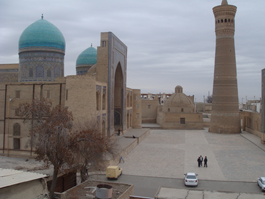Uzbekistan
Country Profile
 Central Asia is a cross road between East and West and Uzbekistan is the center part of it and of the Silk
Road. With 30 million inhabitants, the country is the most populous of the 5 Central Asia Republics. It has
a high level of literacy, a mixed population with a few ethnical groups of which the majority is Uzbek, 3
main historical cities of ancient beauty: Samarkand, Bukhara and Kiva and a very attractive Capital city:
Tashkent. The culture and art level are high first of all for a natural inclination of the population, but
also because during the Second World War the Soviet schools of art had been moved from the center to the
periphery of the large Soviet territory, where they remained many years educating lots of talented and
eager students. The Uzbeks as well as the other ethnical groups such as mainly the Russians, the Tajiks
and the Koreans, added their own imagination and creativity, producing very attractive and interesting
results. On the technical and economic side, the presence of a former and still active Soviet air plane
factory kept the level of technical expertise high, and the Korean Hyundai car factory built in the
Nineties, added modern and appropriate car technology, producing at a very reasonable sales prices.
Unfortunately the rivalry among the Central Asian Countries made it difficult to penetrate the regional
market, reducing the impact and the economic success of Uzbek initiatives. Major economic resources are
various minerals among which Uranium and hydrocarbons, as also large cultivations of cotton ( which however
have damaged the environment, and almost dried up the Lake of Aral), original handicrafts, leather and silk
materials. A large, most important resource for future development is the number of youth under 20 years of
age, which reaches approximately 15 million. Uzbeks are apt dealers and are ready to participate in joint
ventures, trusting that they can obtain know-how from western management expertise. However, occasionally
they delude themselves on their own capacities in terms of what they can offer for meeting the practical
requirements of foreign investors. Therefore, in the mutual interest of a fruitful and lasting cooperation,
it is best to evaluate thoroughly the business environment, questioning if the conditions for success are
there, including appropriate legislation and property regulations. The EU has shown great interest for the
region in its complexity, and has launched an important project of infrastructures and communication called
TRASECA , which aims at reviving the Silk Road. Another important program, named “INOGATE “, also includes
Central Asia and is to establish cooperation in the energy field between EU and 12 Black Sea and Caspian
Sea Countries.
Central Asia is a cross road between East and West and Uzbekistan is the center part of it and of the Silk
Road. With 30 million inhabitants, the country is the most populous of the 5 Central Asia Republics. It has
a high level of literacy, a mixed population with a few ethnical groups of which the majority is Uzbek, 3
main historical cities of ancient beauty: Samarkand, Bukhara and Kiva and a very attractive Capital city:
Tashkent. The culture and art level are high first of all for a natural inclination of the population, but
also because during the Second World War the Soviet schools of art had been moved from the center to the
periphery of the large Soviet territory, where they remained many years educating lots of talented and
eager students. The Uzbeks as well as the other ethnical groups such as mainly the Russians, the Tajiks
and the Koreans, added their own imagination and creativity, producing very attractive and interesting
results. On the technical and economic side, the presence of a former and still active Soviet air plane
factory kept the level of technical expertise high, and the Korean Hyundai car factory built in the
Nineties, added modern and appropriate car technology, producing at a very reasonable sales prices.
Unfortunately the rivalry among the Central Asian Countries made it difficult to penetrate the regional
market, reducing the impact and the economic success of Uzbek initiatives. Major economic resources are
various minerals among which Uranium and hydrocarbons, as also large cultivations of cotton ( which however
have damaged the environment, and almost dried up the Lake of Aral), original handicrafts, leather and silk
materials. A large, most important resource for future development is the number of youth under 20 years of
age, which reaches approximately 15 million. Uzbeks are apt dealers and are ready to participate in joint
ventures, trusting that they can obtain know-how from western management expertise. However, occasionally
they delude themselves on their own capacities in terms of what they can offer for meeting the practical
requirements of foreign investors. Therefore, in the mutual interest of a fruitful and lasting cooperation,
it is best to evaluate thoroughly the business environment, questioning if the conditions for success are
there, including appropriate legislation and property regulations. The EU has shown great interest for the
region in its complexity, and has launched an important project of infrastructures and communication called
TRASECA , which aims at reviving the Silk Road. Another important program, named “INOGATE “, also includes
Central Asia and is to establish cooperation in the energy field between EU and 12 Black Sea and Caspian
Sea Countries.
